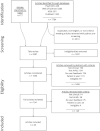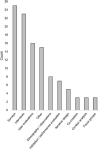Inclusion of Clinicians in the Development and Evaluation of Clinical Artificial Intelligence Tools: A Systematic Literature Review
- PMID: 35465567
- PMCID: PMC9022040
- DOI: 10.3389/fpsyg.2022.830345
Inclusion of Clinicians in the Development and Evaluation of Clinical Artificial Intelligence Tools: A Systematic Literature Review
Abstract
The application of machine learning (ML) and artificial intelligence (AI) in healthcare domains has received much attention in recent years, yet significant questions remain about how these new tools integrate into frontline user workflow, and how their design will impact implementation. Lack of acceptance among clinicians is a major barrier to the translation of healthcare innovations into clinical practice. In this systematic review, we examine when and how clinicians are consulted about their needs and desires for clinical AI tools. Forty-five articles met criteria for inclusion, of which 24 were considered design studies. The design studies used a variety of methods to solicit and gather user feedback, with interviews, surveys, and user evaluations. Our findings show that tool designers consult clinicians at various but inconsistent points during the design process, and most typically at later stages in the design cycle (82%, 19/24 design studies). We also observed a smaller amount of studies adopting a human-centered approach and where clinician input was solicited throughout the design process (22%, 5/24). A third (15/45) of all studies reported on clinician trust in clinical AI algorithms and tools. The surveyed articles did not universally report validation against the "gold standard" of clinical expertise or provide detailed descriptions of the algorithms or computational methods used in their work. To realize the full potential of AI tools within healthcare settings, our review suggests there are opportunities to more thoroughly integrate frontline users' needs and feedback in the design process.
Keywords: artificial intelligence (AI); clinical AI; clinician; evaluation; healthcare; human-centered design; machine learning.
Copyright © 2022 Tulk Jesso, Kelliher, Sanghavi, Martin and Henrickson Parker.
Conflict of interest statement
The authors declare that the research was conducted in the absence of any commercial or financial relationships that could be construed as a potential conflict of interest.
Figures



References
-
- Ash M., Petro J., Rab S. (2019). How AI in the exam room could reduce physician burnout. Harv. Bus. Rev. 2–5. Available online at: https://hbr.org/2019/11/how-ai-in-the-exam-room-could-reduce-physician-b...
Publication types
LinkOut - more resources
Full Text Sources
Miscellaneous

